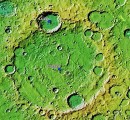There’s no way to actually tell, but humanity’s best guess is that neighboring planet Mars gets hits by some type of space rocks at least 200 times per year, as per the University of Arizona. Most of them are up to 6 feet (2 meters) across, but the effects they have are often dramatic.
You see, Earth gets hit a lot too, but our planet has one thing going for it: it has a respectable atmosphere, one that acts like a shield and usually helps burn incoming rocks before they hit the ground and cause damage or injury.
Mars has an atmosphere too, but it is too thin to make a significant difference when it comes to protecting the planet from impacts. What comes in usually hits, and hits so hard that the effects can be spotted on the barren, sandy surface all the way from space, using the proper tools.
It’s not easy spotting these impacts, but scientists here on Earth do know what to look for. If they’re after relatively new craters, they hunt for the dark spots the Mars Reconnaissance Orbiter’s (MRO) Context Camera can usually see from orbit.
The crater you’re looking at now was discovered thanks to said dark spots, and it’s one of the most recent that we know of on the planet (although the above statistics does point to many more such craters appearing since).
The image, taken in July 2020 from an altitude of 264 km (164 miles) and recently released by the University of Arizona, shows an impact crater that formed anywhere between February 2006 and March 2014. We are provided with no indication of its size or location, but the fact it is pictured right next to another crater is yet another proof of how often the solar system bombards the place.
Understanding how often asteroids hit Mars, and everything related to them is crucial for the planning of future crewed missions to the Red Planet, but also the survival of whatever colony we eventually manage to set up there.
Mars has an atmosphere too, but it is too thin to make a significant difference when it comes to protecting the planet from impacts. What comes in usually hits, and hits so hard that the effects can be spotted on the barren, sandy surface all the way from space, using the proper tools.
It’s not easy spotting these impacts, but scientists here on Earth do know what to look for. If they’re after relatively new craters, they hunt for the dark spots the Mars Reconnaissance Orbiter’s (MRO) Context Camera can usually see from orbit.
The crater you’re looking at now was discovered thanks to said dark spots, and it’s one of the most recent that we know of on the planet (although the above statistics does point to many more such craters appearing since).
The image, taken in July 2020 from an altitude of 264 km (164 miles) and recently released by the University of Arizona, shows an impact crater that formed anywhere between February 2006 and March 2014. We are provided with no indication of its size or location, but the fact it is pictured right next to another crater is yet another proof of how often the solar system bombards the place.
Understanding how often asteroids hit Mars, and everything related to them is crucial for the planning of future crewed missions to the Red Planet, but also the survival of whatever colony we eventually manage to set up there.







